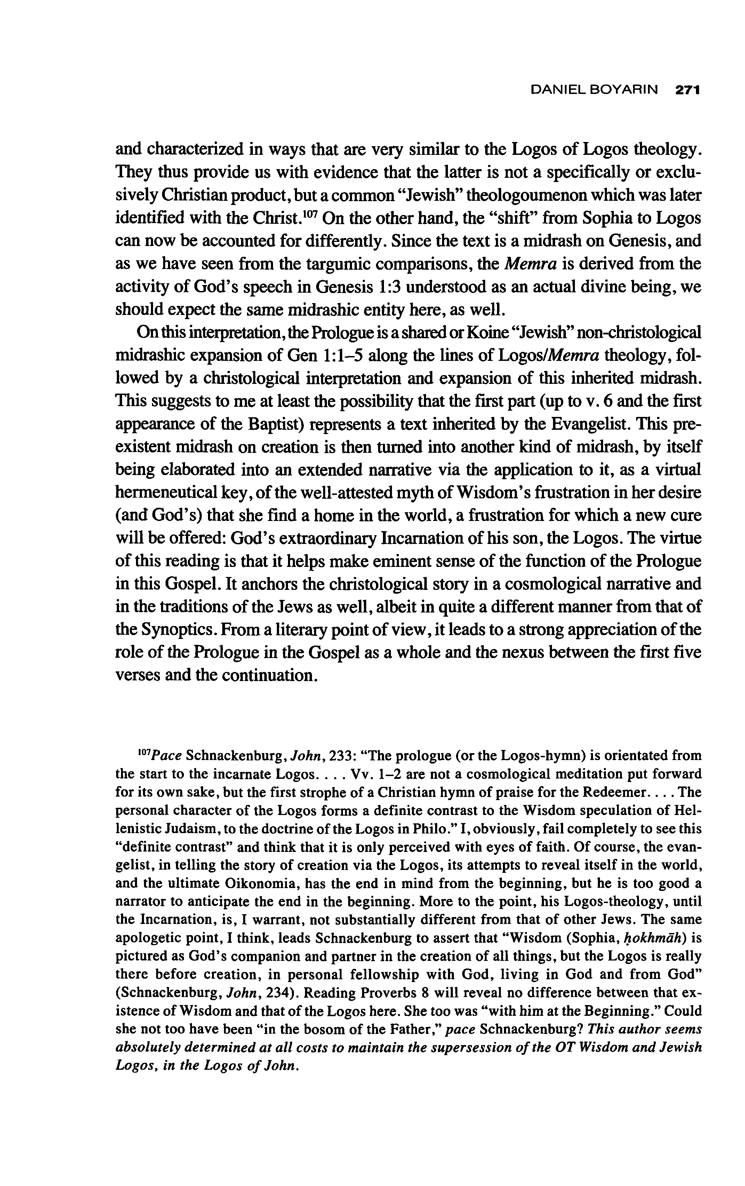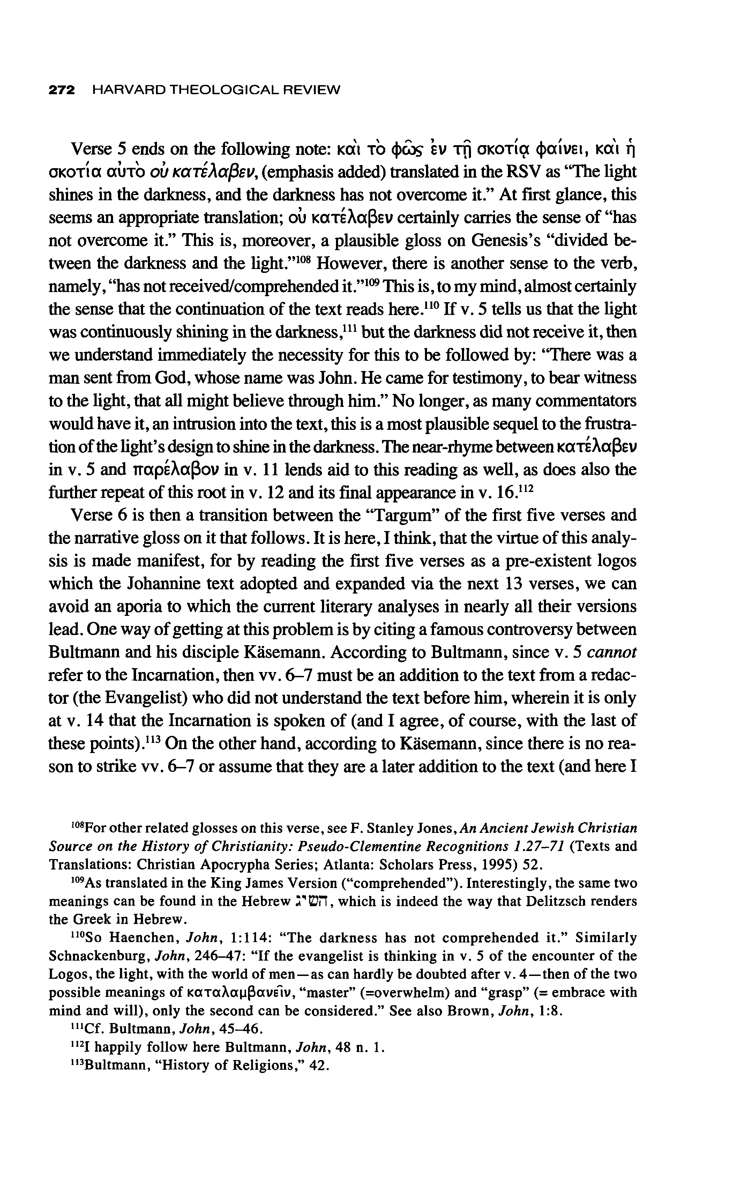erably enhanced.
The vaunted hymnic repetitions of words from strophe to strophe, "In the be-
ginning was the Word, and the Word was God" can be interpreted as an expansion of the formal pattern found already in the first verse of Genesis: "In the beginning
God created the heaven and the earth, and the earth was without form and void."
The assertion that the Word was with God is easily related to Prov 8:30: "Then I
was beside him,"104 and even to Wis 9:9: "With thee is wisdom." On the other
hand, such themes as the arrival of the Word on earth and his living among men
can clearly be traced as allusions to texts like Bar 3:38: "Afterward she appeared
upon earth and lived among men." As frequently with rabbinic midrash, the gloss
on the verse being interpreted is dependent on an alluded-to but not explicitly cited
later biblical text. This can be compared with the Palestinian Targum to this very
verse, which translates "In the beginning" by "With Wisdom God created?105 clearly alluding as well to the Proverbs passage. "Beginning" is read as Wisdom or as the
Logos: By a Beginning—Wisdom—God created. To this midrash should be com-
pared the famous Latin version of John 8:25, so beautifully read by Augustine as
"Your Word, the Beginning who also speaks to us,"106 once again reading "Begin-
ning" twice. As Augustine paraphrases this tradition: "Wisdom is 'the Beginning':
and it is in that Beginning that You made heaven and earth."
Now we can understand the role of the Wisdom hymns differently in the pro-
duction of this text. They are not the formal model for the Prologue to John, but, as
the intertext for the Logos midrash of the Prologue to John, they do provide us
with access to a pre-Christian world of ideas in which Wisdom was personified
103For a convenient summary of previous chiastic structural analyses, see Culpepper, "Pivot,"
6-9 and also Haenchen, John, 1:110, 125.
104Cf. Bultmann, "History of Religions," 36.
105Klein, Fragment-Tar gums, 1:43.
^Confessions 11.8. Augustine, Confessions Books I-XIII (trans. F. J. Sheed; Indianapolis: Hackett, 1993) 217, 254.1 am considerably less persuaded than Raymond Brown that "The
Latin translations give prominence to a mistaken reading which cannot be justified by the
Greek. They take 'the beginning' as a nominative instead of an accusative and render: '[I am]
the beginning who also speaks to you' or '[I am] the beginning because I speak to you' "
(Brown, John, 1:348).

D A N I E L B O Y A R Í N 2 7 1
and characterized in ways that are very similar to the Logos of Logos theology.
They thus provide us with evidence that the latter is not a specifically or exclu-
sively Christian product, but a common "Jewish" theologoumenon which was later
identified with the Christ.107 On the other hand, the "shift" from Sophia to Logos
can now be accounted for differently. Since the text is a midrash on Genesis, and
as we have seen from the targumic comparisons, the Memra is derived from the
activity of God's speech in Genesis 1:3 understood as an actual divine being, we
should expect the same midrashic entity here, as well.
On this interpretation, the Prologue is a shared or Koine "Jewish" non-christological
midrashic expansion of Gen 1:1-5 along the lines of LogoslMemra theology, fol-
lowed by a christological interpretation and expansion of this inherited midrash.
This suggests to me at least the possibility that the first part (up to v. 6 and the first
appearance of the Baptist) represents a text inherited by the Evangelist. This pre-
existent midrash on creation is then turned into another kind of midrash, by itself
being elaborated into an extended narrative via the application to it, as a virtual
hermeneutical key, of the well-attested myth of Wisdom's frustration in her desire
(and God's) that she find a home in the world, a frustration for which a new cure
will be offered: God's extraordinary Incarnation of his son, the Logos. The virtue
of this reading is that it helps make eminent sense of the function of the Prologue
in this Gospel. It anchors the christological story in a cosmological narrative and
in the traditions of the Jews as well, albeit in quite a different manner from that of
the Synoptics. From a literary point of view, it leads to a strong appreciation of the
role of the Prologue in the Gospel as a whole and the nexus between the first five
verses and the continuation.
107 Pace Schnackenburg, John, 233: "The prologue (or the Logos-hymn) is orientated from the start to the incarnate Logos. . . . Vv. 1-2 are not a cosmological meditation put forward
for its own sake, but the first strophe of a Christian hymn of praise for the Redeemer. . . . The
personal character of the Logos forms a definite contrast to the Wisdom speculation of Hel-
lenistic Judaism, to the doctrine of the Logos in Philo." I, obviously, fail completely to see this
"definite contrast" and think that it is only perceived with eyes of faith. Of course, the evan-
gelist, in telling the story of creation via the Logos, its attempts to reveal itself in the world,
and the ultimate Oikonomia, has the end in mind from the beginning, but he is too good a
narrator to anticipate the end in the beginning. More to the point, his Logos-theology, until
the Incarnation, is, I warrant, not substantially different from that of other Jews. The same
apologetic point, I think, leads Schnackenburg to assert that "Wisdom (Sophia, hokhmäh) is
pictured as God's companion and partner in the creation of all things, but the Logos is really
there before creation, in personal fellowship with God, living in God and from God"
(Schnackenburg, John, 234). Reading Proverbs 8 will reveal no difference between that ex-
istence of Wisdom and that of the Logos here. She too was "with him at the Beginning." Could
she not too have been "in the bosom of the Father," pace Schnackenburg? This author seems
absolutely determined at all costs to maintain the supersession of the OT Wisdom and Jewish
Logos, in the Logos of John.

2 7 2 HARVARD T H E O L O G I C A L REVIEW
Verse 5 ends on the following note: και το φω£ εν τη σκοτία φαίνει, και ή
σκοτία αυτό ου κατέλαβε)/, (emphasis added) translated in the RSV as "The light
shines in the darkness, and the darkness has not overcome it." At first glance, this
seems an appropriate translation; ου κατέλαβεν certainly carries the sense of "has
not overcome it." This is, moreover, a plausible gloss on Genesis's "divided between the darkness and the light."108 However, there is another sense to the verb, namely, "has not received/comprehended it."109 This is, to my mind, almost certainly
the sense that the continuation of the text reads here.110 If v. 5 tells us that the light
was continuously shining in the darkness,111 but the darkness did not receive it, then
we understand immediately the necessity for this to be followed by: "There was a
man sent from God, whose name was John. He came for testimony, to bear witness
to the light, that all might believe through him." No longer, as many commentators
would have it, an intrusion into the text, this is a most plausible sequel to the frustration of the light's design to shine in the darkness. The near-rhyme between κατέλαβεν
in v. 5 and παρέλαβον in v. 11 lends aid to this reading as well, as does also the
further repeat of this root in v. 12 and its final appearance in v. 16.112
Verse 6 is then a transition between the "Targum" of the first five verses and
the narrative gloss on it that follows. It is here, I think, that the virtue of this analysis is made manifest, for by reading the first five verses as a pre-existent logos which the Johannine text adopted and expanded via the next 13 verses, we can
avoid an aporia to which the current literary analyses in nearly all their versions
lead. One way of getting at this problem is by citing a famous controversy between
Bultmann and his disciple Käsemann. According to Bultmann, since v. 5 cannot
refer to the Incarnation, then vv. 6-7 must be an addition to the text from a redac-
tor (the Evangelist) who did not understand the text before him, wherein it is only
at v. 14 that the Incarnation is spoken of (and I agree, of course, with the last of
these points).113 On the other hand, according to Käsemann, since there is no rea-
son to strike vv. 6-7 or assume that they are a later addition to the text (and here I
108For other related glosses on this verse, see F. Stanley Jones, An Ancient Jewish Christian
Source on the History of Christianity: Pseudo-Clementine Recognitions 1.27-71 (Texts and
Translations: Christian Apocrypha Series; Atlanta: Scholars Press, 1995) 52.
109As translated in the King James Version ("comprehended"). Interestingly, the same two
meanings can be found in the Hebrew ITETI, which is indeed the way that Delitzsch renders





